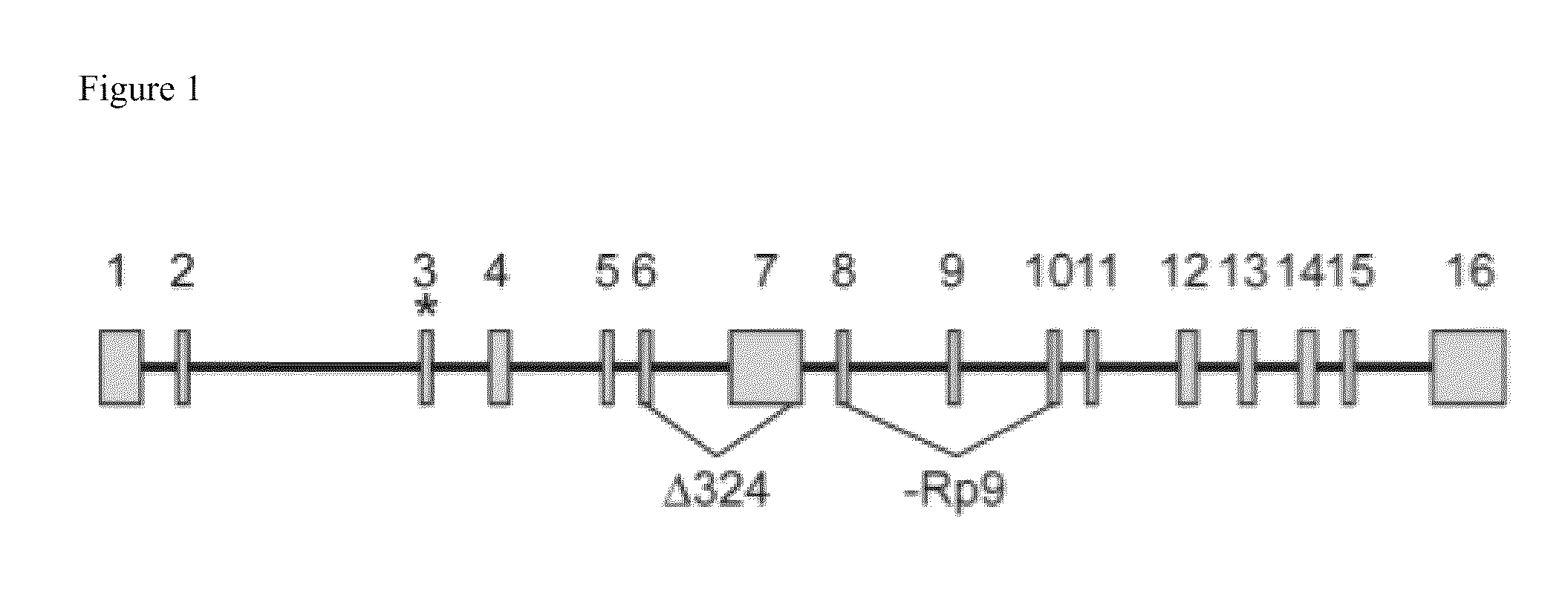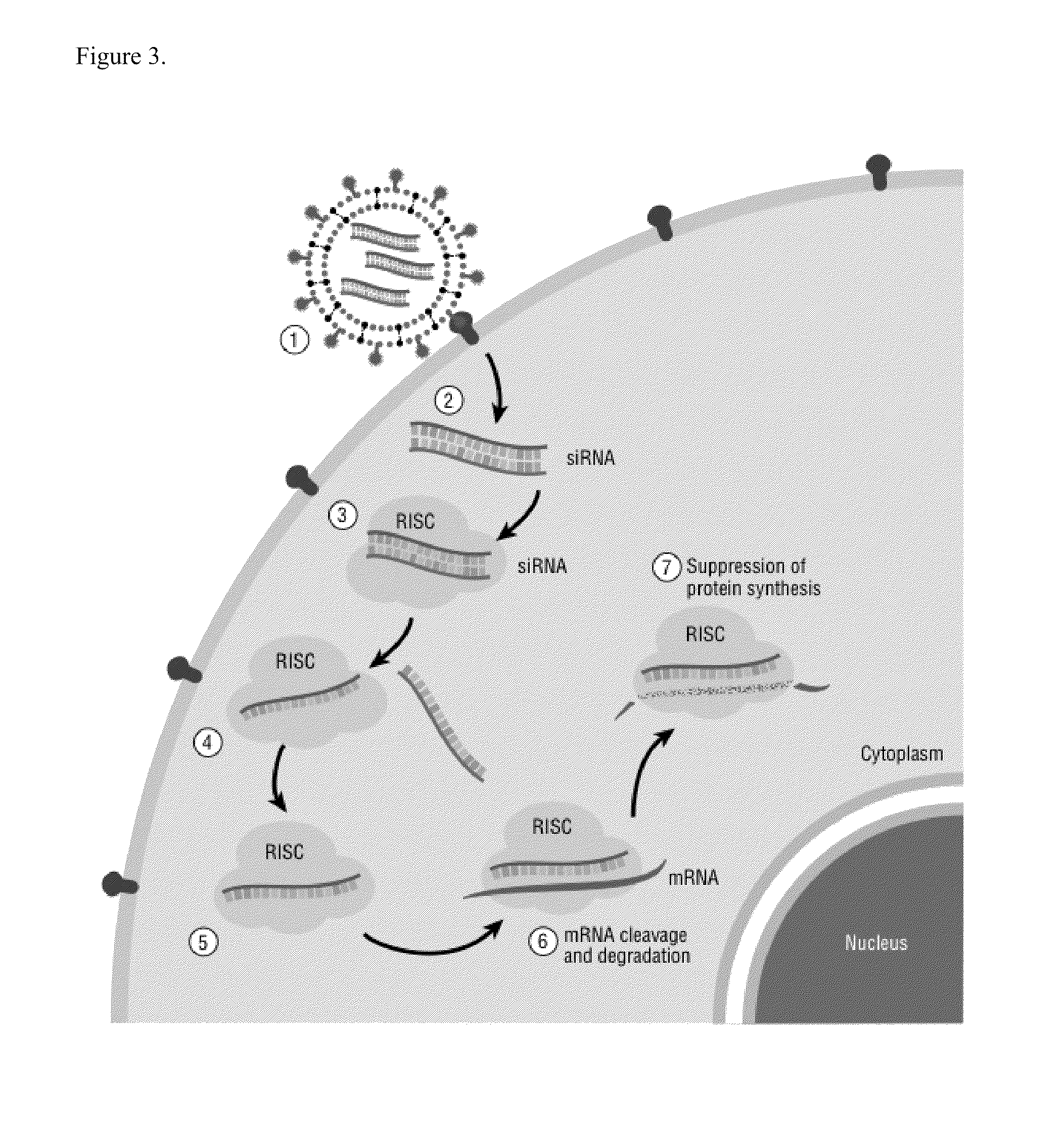Reagents and methods for treating cancer
a technology of reagents and cancer, applied in the field of cancer and reagents and methods for treating cancer, can solve the problems of evi1 interference, uncontrolled growth, invasiveness and other phenotypic hallmarks, etc., and achieve the effects of reducing side effects of cancer therapy, sparing normal tissues, and increasing the potency and efficacy of therapy
- Summary
- Abstract
- Description
- Claims
- Application Information
AI Technical Summary
Benefits of technology
Problems solved by technology
Method used
Image
Examples
example 1
[0127]In a preferred embodiment of the invention, the EVI1 inhibitor is a 21 bp small interfering RNA (siRNA). In silico analysis of the human EVI1 isoform 1b mRNA was performed using algorithms that identify potentially potent siRNAs capable of silencing EVI1 expression. Five core target sequences to which siRNAs provide potent EVI1 down-regulators are presented in Table 1 (SEQ ID NOs: 2-6). The corresponding siRNAs to these target sites A (SEQ ID NOs: 7-8), B (SEQ ID NOs: 9-10), C (SEQ ID NOs: 11-12), D (SEQ ID NOs: 13-14), and E (SEQ ID NOs: 15-16) are presented in Table 2. Sequences focused around the 256 core (SEQ ID NO 2) are presented in Table 3 (SEQ ID NOs 17-56). Sequences focused around the 979 core (SEQ ID NO 3) and the 992 core (SEQ ID NO 4) are presented in Table 4 (SEQ ID NOs 57-120). Sequences focused around the 2910 core (SEQ ID NO 5) are presented in Table 5 (SEQ ID NOs 121-160). Sequences focused around the 2994 core (SEQ ID NO 6) are presented in Table 6 (SEQ ID N...
example 2
[0129]For a substance to be an effective cancer therapeutic agent, it needs a robust cancer killing effect at very low concentrations, which for siRNA will be understood to be at subnanomolar concentrations in cell culture. The concentration of siRNA that inhibited growth of ovarian tumor cells by 50% (IC50) was determined by measuring cell viability 96 hours after adding one of various dose levels of siRNA to identical numbers of tumor cells in culture. FIG. 6A shows the IC50 of siEVI1-979 (SEQ ID NOs 9-10) for ES-2 cells is ˜2.5 nM, and the IC50 of siEVI1-2910 (SEQ ID NOs 13-14) is ˜0.5 nM. For TOV-112D cells, the IC50 of siEVI1-979 (SEQ ID NOs 9-10) is ˜4 nM, and the IC50 of siEVI1-2910 (SEQ ID NOs 13-14) is ˜0.8 nM. To further identify potent sequences that inhibit the growth of ovarian tumor cells, sequences of up to 10 bp upstream and 10 bp downstream of siEVI1-2910 (SEQ ID NOs: 121-160) were prepared and administered to ES-2 and TOV-112D ovarian tumor cells at a concentration...
example 3
[0130]Potent siRNA inhibitors of EVI1 can reduce the growth of tumors in mice following direct injection into the tumors. To assess siRNA potency, three million ovarian metastatic tumor cells are injected into female nude mice subcutaneously and tumors permitted to grow over a period of ten days. Up to five injections of 10 microliters each containing 1 nmol siRNA encapsulated into liposome nanoparticle are injected immediately underneath the tumors twice weekly for three weeks. An equal number of mice bearing similar tumors are injected with nanoparticle containing a scrambled siRNA sequence as a negative control. The tumors are removed after three weeks of dosing and measured and weighed. For potent siRNA species, tumors in mice dosed with siRNA targeting EVI1 are expected to have tumors averaging ˜10% the size of those dosed with scrambled siRNA sequence. These results provide a demonstration of the efficacy and potency of the siRNA targeting EVI1 as an anticancer therapy. Overal...
PUM
| Property | Measurement | Unit |
|---|---|---|
| apparent molecular weight | aaaaa | aaaaa |
| pH | aaaaa | aaaaa |
| pH | aaaaa | aaaaa |
Abstract
Description
Claims
Application Information
 Login to View More
Login to View More - R&D
- Intellectual Property
- Life Sciences
- Materials
- Tech Scout
- Unparalleled Data Quality
- Higher Quality Content
- 60% Fewer Hallucinations
Browse by: Latest US Patents, China's latest patents, Technical Efficacy Thesaurus, Application Domain, Technology Topic, Popular Technical Reports.
© 2025 PatSnap. All rights reserved.Legal|Privacy policy|Modern Slavery Act Transparency Statement|Sitemap|About US| Contact US: help@patsnap.com



